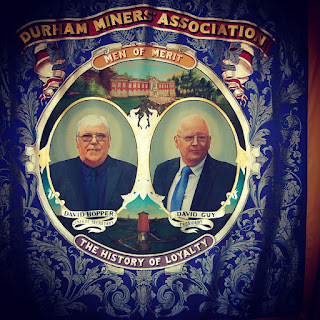A John Midgley made banner
John Midgley banners made for the Durham Miners
The baton of political protest was picked up by various feminist movements in the 1970s and perhaps the most well known of the artists who came to prominence at that time, who also used banners, was Judy Chicago.
Judy Chicago: Drawing for a banner
Judy Chicago banners and woven banner making
Judy Chicago is very aware of the religious background out of which socialist banner making emerged and uses biblical text to make her own pronouncements. She also has some of her banners woven, an aspect of her overarching project of feminist awareness raising; in this case of society's association of women's work with craft and craft's difficult relationship with 'fine art'. A relationship that had seen a divide open up between two very different value systems; on the one hand 'men' being regarded as being 'genius' artists who belong to the avant-garde, while women being regarded as the craftspeople, who carry on traditional values.
Both John Midgley and Judy Chicago were making their statements in the 1970s, Midgley in many ways working in a tradition that was fast disappearing, and Chicago being in the vanguard of a movement that was becoming more and more powerful.
The banner continues to be an important communication vehicle, it still fulfils its historic function, church parades continuing to take place with banners carried aloft. However banners can also be still be used to raise the profile of those who find themselves marginalised or dismissed by society as being unproductive or a problem. The Harris Galley's recent exhibition, 'The Unfurlings: Banners for Hope and Change', saw a collaboration between groups of people from across the UK working with artist Ian Beesley and poet Ian McMillan to create banners that were designed to be centre pieces around which a campaign for a better understanding of dementia could be built.
Hamari Yaadain: Banner
Ian McMillan wrote a poem to accompany every banner, this poem was the one he wrote to support the Hamari Yaadain banner. This collaborative venture giving the project a rich complexity in its realisation. I have not posted on community art practices before, but it should not be forgotten how drawing is still central to person to person communication and ideas development. Ian Beesley as the lead artist will have had to make a variety of drawings in order to both help design the banners and to show all the other collaborators how their various ideas could be made to fit in or in some cases he would have had to make drawings to show how one idea would work better than another. Drawing is for the community artist a key tool, often being used as the glue to hold everything together.
The banner still continues to be used to carry political messages, Cauleen Smith's 'I Cannot Be Fixed', or 'Leave me for the crows', are banners that have emerged from a practice that encompasses moving image, installation, textile, drawing, and performances that double as community gatherings.
Cauleen Smith
It is perhaps in Smith's work that we see a more contemporary approach, the banner being one aspect of a multi faceted practice that attempts to embrace the viewer within an immersive environment designed to work across a wide range of sensibilities. This is not new, think of the banners hung in a church, they would be set alongside stained glass, sculpture, incense burning, candles and music.
Cauleen Smith, Epistrophy, 2018, multichannel video, four CCTV cameras, four monitors, projection, custom wood table, stuffed raven, wood figures, bronze figures, plastic figures, books, seashells, minerals, jar of starfish, Magic 8-Ball, maneki-neko, mirror, metal trays, plaster objects, wood objects, wire object, fabric, glass vase and plants
If you want to see a banner being used as part of a multi-media environment you could look at Mel Brimfield's exhibition that is on at the Tetley in Leeds at the moment. 'From this world, to that which is to come', which is named after a quote from Pilgrim's Progress. The banner in this case being about collectivity and the need to unite in collective protection in times of stress and need.
See also:

















Great Blog. Such an amazing article. I really enjoyed this article. PrintMagic Also Avail Design Services for your Fabric Banners by adding this service to the above calculator. Send us your required specifications and we’ll create the design from scratch, completely unique, and by matching your needs and for brand messaging. Once you approve the fabric banner printing design, we will get them printed and delivered to your doorstep!
ReplyDelete